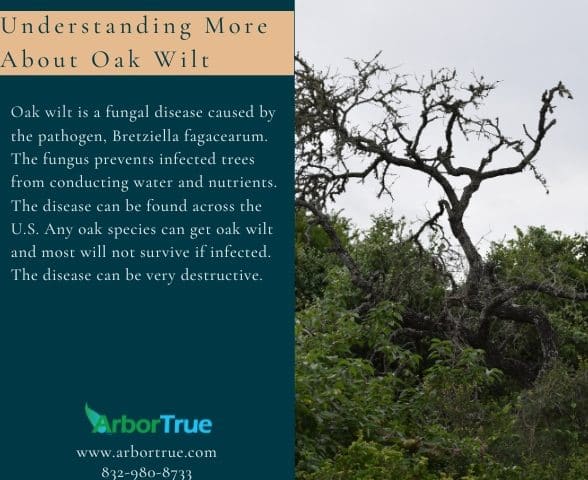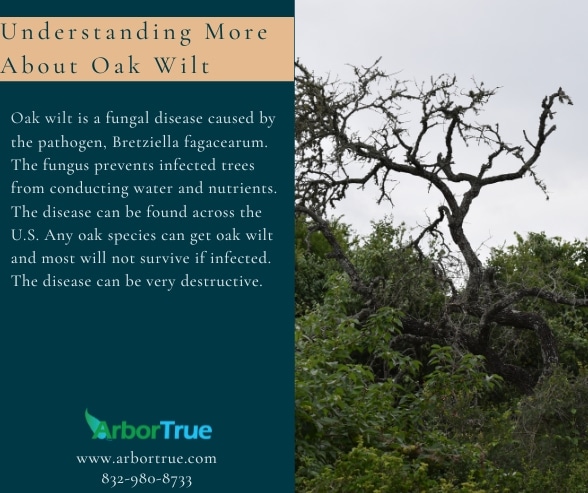
The Truth Cracked Open! Almonds Aren’t Really Nuts!
February 7, 2024
Mushroom Monday: Ugly Milkcap
February 12, 2024
Understanding More About Oak Wilt
You may have been hearing more about oak wilt in the news recently. In today’s post, we will give you some information about this devastating disease.
What is Oak Wilt?
Oak wilt is a fungal disease caused by the pathogen, Bretziella fagacearum. The fungus prevents infected trees from conducting water and nutrients. The disease can be found across the U.S. and has created problems in many places, including Texas. Any oak species can get oak wilt, and most will not survive if infected. A tree can die in as little as two months if infected. The disease can be very destructive.
Do All Oak Tree Species Respond the Same Way to Oak Wilt?
Although all species of oak tree can get oak wilt, they respond to it differently. Red oaks are particularly susceptible to the disease and will die if they get it. Red oaks can be the trees where the infection starts in an area. Live oaks that catch the disease can be treated if the disease is found soon enough. The treatment can be costly though. Also, if the disease isn’t found soon, live oaks will die in the majority of cases. Among oaks, white oaks are more resistant to oak wilt than some other species, but they can still get and die from it.
How is Oak Wilt Transmitted?
Oak wilt can be transmitted in different ways.
Oak wilt can be carried by a beetle. The beetles can infect healthy trees that have wounds, have been pruned at the wrong time of year (some recommend avoiding pruning oaks from February through June to limit the spread of the disease), or have been pruned incorrectly. The kind of beetle that carries it are called sap beetles. It isn’t just one type of beetle, but rather a category. Among other things, the beetles eat the mycelium of the fungus that is under the bark of infected trees. They can then go to healthy trees that have wounds and spread the fungus on their feet.
Oak wilt can also be transmitted via the roots of trees. Root transmission can be a particular problem for live oaks. Live oaks can have roots that mix with each other, and this can allow the disease to spread.
What are Some Signs of Oak Wilt?
Only a trained expert can properly diagnose oak wilt. Laboratory analysis can be needed to confirm diagnosis. There are some signs that can indicate the disease.
One indication of the disease can be changes in the leaves of oaks. Live oaks, for example, can develop yellow veins that turn brown. In other cases, the veins can turn darker when compared to the other leaf areas. In other situations, leaf edges can turn brown on infected trees.
In red oaks, these leaf symptoms might be less noticeable. In red oaks, leaves can wilt, turn pale or brown, and then fall. Infected trees can exhibit what would be considered “fall color” in the summer when they are infected. Red oaks die when they get oak wilt. They can die in as little as four to six weeks once they show symptoms.
Another indication of oak wilt are fungal mats. Fungal mats form under the bark of infected trees where the fungus has spread. Fungal mats don’t form on all species of oaks nor in all situations. As mentioned, sap beetles eat the mycelium in these mats and that is how they pick up the fungus to spread the disease. Fungal mats can also form on cut wood like logs and stumps.
These are just some symptoms of oak wilt. Many things can impact oak trees and only a trained arborist can identify what is affecting particular trees.
Are There Any Treatments or Preventative Measures for Oak Wilt?
In some cases, trees that get oak wilt can be treated by a trained professional. The treatment involves the professional application of a fungicide called propiconazole. The fungicide is applied and then reapplied periodically to prevent reinfection. The fungicide won’t stop oak wilt from spreading, but it can help a tree that already has it. It isn’t effective in all cases.
Although fungicide can be used to treat some species of oak trees, it can’t be used to treat red oaks. Red oaks will die if they get oak wilt. However, fungicide can be used as a means to prevent oak wilt in red oaks and live oaks.
Another form of prevention involves trenching done by a professional. Trenching cuts the roots of infected trees off from roots of uninfected trees. By cutting a trench, the disease can be stopped from spreading via the roots of trees.
There are other means to prevent the spread of oak wilt. They involve:
- The professional removal of infected trees and their proper disposal
- Proper pruning of trees in terms of time of year and technique
- Proper handling of firewood
- Planting a diversity of trees in landscapes
Oak wilt is a devastating tree disease. If you have any concerns about oak wilt, contact a trained arborist. They can assess the situation and provide you with information.




